The opportunities in India for engineers to bag core jobs might be limited, but lighting is an exciting and challenging field to work in, regardless of whether your interests are design, manufacturing, sales or business. There are quite a few companies offering roles in research and development, design, testing and validation. Entrepreneurship is also a path taken by many to kick-start a venture in the lighting industry. Let us take a look at the opportunities available today.
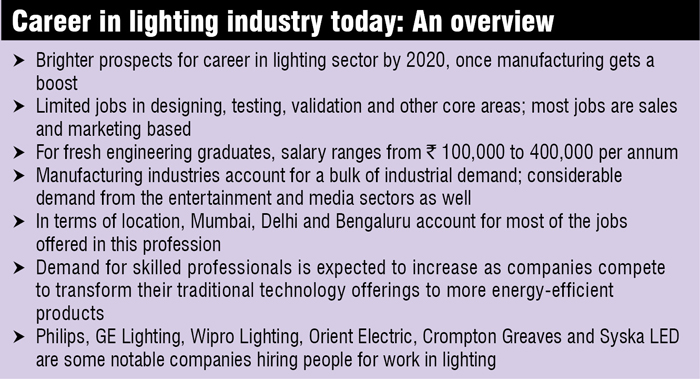
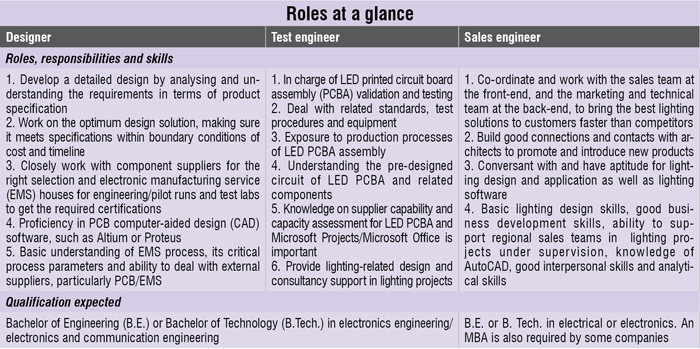
You could be a designer, design assistant or design technician
Although on a limited scale, multinational companies such as Philips hire designers and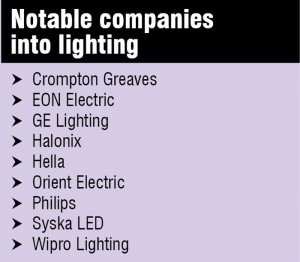 design assistants for their lighting division.
design assistants for their lighting division.
Roles and responsibilities. Designers are in charge of developing a detailed design by analysing and understanding the requirements in terms of product specification. They are responsible for a detailed design of light emitting diode (LED) boards and systems, as per the specifications and architecture given. They work on the optimum design solution and make sure it meets specifications within boundary conditions of cost and timeline. They are also responsible for preparing test samples, test plans, design documents and to maintain test set-up in the development. On a regular basis, they interact with quality teams for validating platform, module or product designs.
This function, as a designer or design assistant, requires closely working with component suppliers for the right selection and electronic manufacturing service (EMS) houses for engineering/pilot runs and test labs to get the required certifications. A designer’s support in project estimation, planning and risk management activities is highly valuable. Overall, this position needs high level of domain knowledge and networking ability in a cross-functional environment.
On the other hand, a design technician deals with printed circuit board (PCB) mounting, sample making, and test and documentation as per requirements with respect to LED lamps.
Skills. The most required skill for a designer in the lighting industry is proficiency in PCB computer-aided design (CAD) software, such as those by Altium or Proteus. Along with good analytical skills, a designer is also expected to understand technical specifications of LEDs and PCBs. Basic understanding of the EMS process, its critical process parameters and ability to deal with external suppliers, particularly PCB/EMS, are some other skills that, if developed, can keep you ahead in the competition and possibly reward you with a great job. Good communication skills are also important for meetings and presentations.
A design technician is expected to have strong fundamentals in electronics as well as good communication skills.
Educational qualification. Bachelor of Engineering (B.E.) or Bachelor of Technology (B.Tech.) in electronics engineering/electronics and communication engineering is required.
You could be a marketing and sales officer
Lighting sales representatives are at the helm for selling lighting products. Some work as employees of lighting manufacturing organisations, but most are employed by independent agencies that have contracts to sell products of several lighting companies in a specific city, state, region or country. This area is where majority of the jobs in lighting sector are available. An engineering degree is a pre-requisite for most companies.
Roles and responsibilities. Positions in this side of lighting domain are usually titled sales engineer, lighting application specialist, sales officer, lighting sales representative, sales executive and lighting sales engineer, among others. Generally, a sales engineer is expected to provide lighting design and consultancy support in lighting projects. He or she must co-ordinate and work with the sales team at the front-end, and the marketing and technical teams at the back-end to bring the best lighting solutions to customers, faster than competitors. An engineer is expected to achieve growth in sales through effective networking within assigned territory. The area of coverage is usually allocated after posting, and this job requires extensive travelling, at least 50 per cent of the time. He or she must also have good connections and contacts with architects to promote and introduce new products.
Skills. An engineer should be conversant with and have aptitude for lighting design and application as well as lighting software. With a good grip on communication, he or she should be able to interact with architects, engineering consultants and professional end-users. Basic lighting design skills, good business development skills, ability to support regional sales teams in lighting projects under supervision, knowledge of AutoCAD, good interpersonal skills and analytical skills (to keep track of competition activity in the market) are some other aspects that recruiters look for. Experience of working with architects and consultants is an added advantage. Recruiters prefer engineers with good interpersonal skills and skillful organisation of tasks, along with the ability to work with little or no supervision.
Educational qualification. B.E. or B. Tech. in electrical or electronics is required. An MBA is also preferred by some companies.
You could also be a test engineer
Companies who develop and manufacture lighting fixtures and electronics for domains such as automotive industry usually hire test engineers, although these jobs are limited.
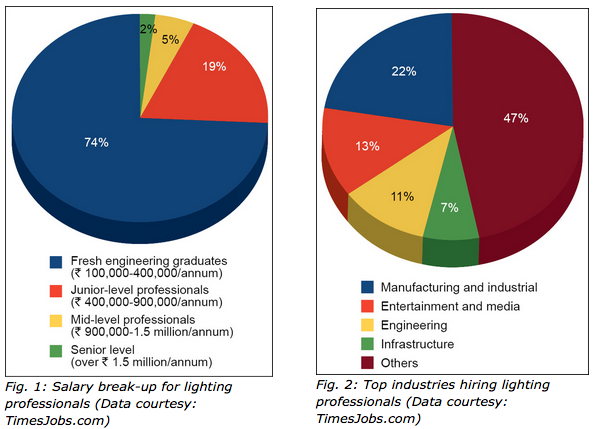
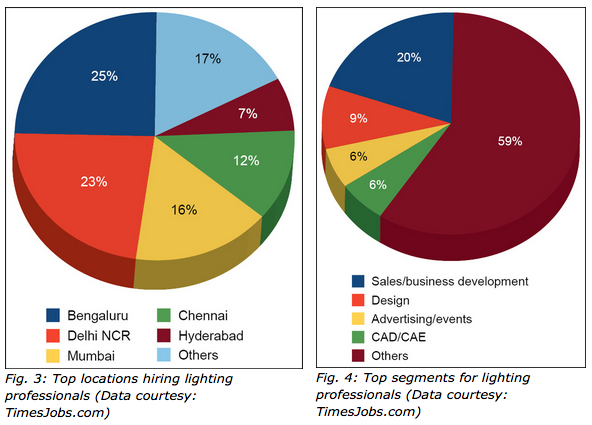
Roles, responsibilities and skills expected. A test engineer will be in charge of LED printed circuit board assembly (PCBA) validation and testing, and will deal with related standards, test procedure and equipment. He or she will also get exposure on production processes of LED PCBA assembly. The engineer must be capable of understanding the pre-designed circuit of LED PCBA and related components. Knowledge of supplier capability and capacity assessment for LED PCBA and Microsoft projects/Microsoft office is expected.
Pay package
Going by the statistics provided by TimesJobs.com, a massive 74 per cent of the jobs for fresh engineering graduates in the lighting industry fall in the salary range of Rs. 100,000 to 400,000 per annum. Around 19 per cent jobs for junior-level professionals pay anywhere from Rs. 400,000 to 900,000 per annum, while 5 per cent jobs for mid-level pay between Rs. 900,000 and 1.5 million yearly.
Demand areas
“Lighting accounts for nearly half of the total energy consumed in most home and office environments, and so it is natural that lighting companies are focused on the development of energy-efficient lighting, leading to a good demand for young professionals in this field,” informs Vivek Madhukar, COO, TimesJobs.com. He adds, “Demand for skilled professionals is expected to increase as companies compete to transform their traditional technology offerings to more energy-efficient products.”
According to TimesJobs.com, the manufacturing sector tops the list of industries hiring engineers to work in the lighting domain with about 22 per cent share of jobs, followed by the entertainment and media industry with a share of 13 per cent. Engineering and infrastructure segments offer 11 per cent and 7 per cent of the jobs, respectively.
Geographically speaking, Bengaluru tops the list of locations offering jobs for lighting professionals with a 25 per cent share. Delhi (with jobs in the national capital region) comes in next with 23 per cent, Mumbai with 16 per cent, Chennai with 12 per cent and Hyderabad with 7 per cent. Remaining jobs are scattered in other locations.
The data provided by TimesJobs.com also shows that a high percentage of jobs today in India are in the sales and business development side. The other areas, where there are openings for work related to lighting, are designing, advertising/events and CAD/computer-aided engineering (CAE). Refer to the pie-chart for information on the percentage share for each of these areas.
Expect a colourful career in lighting by 2020
It is predicted that by 2020, the lighting industry would have expanded significantly, with LED lighting accounting for over 50 per cent of the total lighting market in India. India’s newly-formed government’s emphasis on energy-efficient lighting systems will also give a boost to the manufacturers and, in turn, generate employment for this sector. A career in this industry will have brighter prospects in the future.






